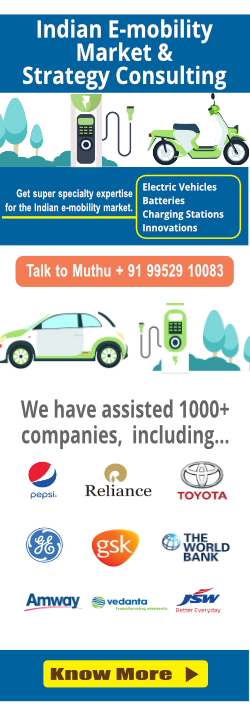Last updated: February 2020 by Narasimhan Santhanam
This pos![]() t is a part of EV Next’s EV Perspectives.
t is a part of EV Next’s EV Perspectives.
EV Next, a division of EAI, is a leading market intelligence & strategic consulting firm for the Indian e-mobility sector.
Get to know about 1000+ EV innovations from EVI2: Electric Vehicle Innovation Intelligence from EVNext
Introduction
Different segments of vehicles (2W, 3W, PVs, CVs) may require a different type of charging standard (& connector), however, the charging infrastructure, at least at public places, should be common to the extent possible to reduce the infra cost.
Energy companies (like IOCL, HPCL, IGL etc.) may invest in providing a charging network, especially the fast charging stations at inter-city routes like state and national highways. This could also be based on renewable electricity sources.
Automotive Industry Standard – AIS 138 Part 1 (both slow charging standard and fast charging standard) is suitable for all vehicle segments as an AC charging standard and may be notified. AIS 138 Part 2 could be finalized after considering the following requirements/provisions.
For 2/3 Wheelers: A new standard unified connector is being considered which could be used both for AC and DC charging to alleviate the need for two separate slots on the vehicle for AC and DC charging respectively. IEC 62196-2 Connector (commonly known as Type-2) is one of the proposals being evaluated.
For 4-wheelers with system voltage not exceeding ~ 100 V: GB/T connector, as per the specs are given under BEVC DC-001 (Bharat EV Charger DC-001), is suitable.
For 4-wheelers with system voltage exceeding ~ 100 V deployment of “publicly available or public” DC fast chargers in the country the recharging points at such charging stations may be equipped at least with protocol and connector of the combined charging system CCS-2 (as described in the Annex-C of AIS 138 Part-2).
Further, the charging station/point installed by any private entity or individual for private purpose or for specific users, DC charging standard as described in Annex-A of AIS 138 Part-2 (i.e. Chademo) shall also be permissible
Standards for EV Chargers in India
- ARAI had published these standards in 2016 and the DHI invited Industry response to the same
- DHI along with Niti Aayog has proposed standards for EV Chargers in India
- The details of these standards could be found in the link – http://dhi.nic.in/writereaddata/UploadFile/REPORT%20OF%20COMMITTEE.pdf
Some key points on the EV Chargers
- The charging equipment must be CE Certified
- The charging equipment must come with a comprehensive extended on-site warranty and AMC package for 5 years from the date of commissioning and must have a design life of 10 years
- The charging equipment before delivery, should be type tested as per AIS 138 at ARAI (Automotive Research Association of India) and IIT Madras
- Development of Charging station infrastructure plays a major role in the development of EV eco system. The Committee on standardization of protocol for Electric Vehicles (EV) Charging Infrastructure has come out with recommendations entailing specifications for AC and DC charging for electric vehicles.
- These standards are called – Bharat EV Charger AC-001 and Bharat EV Charger DC-001. India will deploy both CHAdeMO and Combined Charging System (CCS) fast-charging technologies, besides the existing Bharat Standard, at its public electric vehicle charging stations.
- Bharat EV Charger DC-001 specifications recommend the China based GB/T connector standard. Also Indian electric cars and electric buses use the GB/T port on the vehicles for DC fast charging.
- The main reason to adopt GB/T connector can be the cost compared to CHAdeMO or CCS. The focus of global OEM companies (car companies) on Asian market can also be a reason.
- The first half of the decade is expected to be the Ac charging infrastructure period as the cost factor of Dc chargers plays a major role in the adoption of DC Chargers. CCS and GB/T allows Ac charging as well as dc charging, While India specific Bharat AC-001 allows Ac slow and Ac fast charging.
- During the second half the DC chargers price trends are expected to go low and it will be economical as well as time saving,So the Dc chargers will gain momentum.
There are four or so DC Fast Charging connectors currently being used by electric car manufacturers all over the world.
- CHAdeMO – Nissan and other Japanese companies like Mitsubishi
- SAE Combo Charging System (CCS) – (BMW, GM, VW, and other carmakers)
- Supercharger – Tesla standard connector
- GB/T – BYD among other Chinese companies use this. Mahindra and Tata electric cars also use this standard
The Government of India and Ministry of power released Revised guidelines and standards for charging infrastructure on 1st October,2019. And the inferences of the same is mentioned below. (Document )
Objectives
- To enable faster adoption of electric vehicles in India by ensuring safe, reliable, accessible and affordable Charging Infrastructure and ecosystem.
- TO promote affordable tariff chargeable from EV owners and Charging Station Operators/Owners.
- To generate employment/income opportunities for small entrepreneurs.
- To proactively support the creation of EV Charging Infrastructure in the initial phase and eventually create a market for EV Charging business.
- To encourage the preparedness of Electrical Distribution System to adopt EV Charging Infrastructure.
Tariff for supply of electricity to EV Public Charging Stations
- The tariff for supply of electricity to EV Public Charging Station shall be determined by the appropriate commission in accordance with the Tariff Policy issued under section 3 of Electricity Act 2003 as amended from time to time.
- The tariff applicable for domestic consumption shall be applicable for domestic charging.The separate metering arrangement shall be made for PCS so that consumption may be recorded and billed as per applicable tariff for EV charging stations.
Priority for Rollout ofEV Public Charging Infrastructure
After extensive consultations with State Governments and different Departmental Agencies of Central Government, phasing as follows are laid down as a national priority for rollout of EV Public Charging Infrastructure:
- Phase I (1-3 Years)
All Mega Cities with a population of 4 million-plus as per census 2011, all existing expressways connected to these Mega-Cities & important Highways connected with each of these Mega Cities may be taken up for coverage.
- Phase II (3-5 Years)
Big cities like State Capitals, UT headquarters may also be covered for distributed and demonstrative effect. Further, important Highways connected with each of these Mega Cities may be taken up for coverage. The above priorities for phasing of rollout may be kept in mind by all concerned, including, different agencies of Central/State Governments while framing of further policies/guidelines for Public Charging Infrastructure of EVs, including for declaring further incentives/subsidies for such infrastructure and for such other purposes.
Service charges at PCS
Charging of EVs is a service as already clarified by Ministry of Power vide
letter No. 23/08/2018-R&R dated 13.04.2018.
- In such cases where the PCS/FCS has been installed with Government Incentives (financial or otherwise), State Nodal Agency/State Government/Appropriate Commission shall fix the ceiling of Service Charges to be charged by such PCS/FCS.
Location Of Public Charging Stations
In case of Public Charging Stations, the following requirements are laid down with regard to density/distance between two charging points:
- At least one Charging Station shall be available in a grid of 3 Km X 3 Km. Further, one Charging Station shall be set up at every 25 Km on both sides of highways/roads.
- For long-range EVs and/or heavy-duty EVs like buses/trucks etc., there shall be at least one Fast Charging Station at every 100 Kms, one on each side of the highways/road located preferably within/alongside the stations laid in para 3 above. Within cities, such charging facilities for heavy-duty EVs may be located within Transport Nagars, bus depots.
- Additional PCS/FCS can be installed even if there exists a PCS/FCS in the required grid or distance.
- The above density/distance requirements shall be used by the concerned state/UT Governments/their Agencies for the purposes of land use planning for public charging stations as well as for priority in installation of distribution network including transformers/feeders etc. This shall be done in all cases including where no central/state subsidy is provided.
- The appropriate Governments (Central/StaVUTs) may also give priority to existing retail outlets (ROs) of Oil Marketing Companies (OMCs) for installation of Public EV Charging Stations (in compliance with safety norms)to meet the requirements as laid above. Further, within such ROs, Company Owned and Company Operated (COCO) ROS may be given higher preference.
Know more on the EV charging ecosystem in India from: Components of EVSE | Bharath DC001 | Bharat AC001 | EVSE Growth Trends | Battery Swapping Growth Trends | EVSE Cost components | EVSE installation costs | Battery swapping in India | Indian EVSE Stakeholders | Charger Standards | Current Indian EVSE status | EVSE Challenges | EVSE during 2020-2030 |
![]() Know more on how EV Next can assist your business in your strategy for the e-mobility and electric vehicles sectors, Here
Know more on how EV Next can assist your business in your strategy for the e-mobility and electric vehicles sectors, Here
Wish to know everything about India’s EV market from one place? Check out the India EV Expert Guide, an 800 page comprehensive guide to the Indian EV market. Here
Get to know about 1000+ EV innovations from EVI2: Electric Vehicle Innovation Intelligence from EVNext
See also the blog posts:
- Indian EV Startup Investments – Electric Vehicle Company Funding, Partnerships, M&A
- U S. and Chinese Electric Vehicle Policies – EV Policy Comparison for the United States & China
- Global MOVE Summit 2018 – Highlights, Policy Announcements, Insights, Investments…
Comprehensive Inputs on Indian EV Ecosystem
Check out the following sections for comprehensive inputs on Indian EV ecosystem (click on each section for more details)










